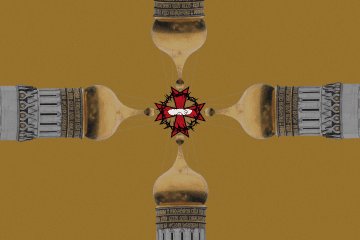- Category
- World
Who Holds Nuclear Weapons Today and How Russia is Undermining the Non-Proliferation Treaty
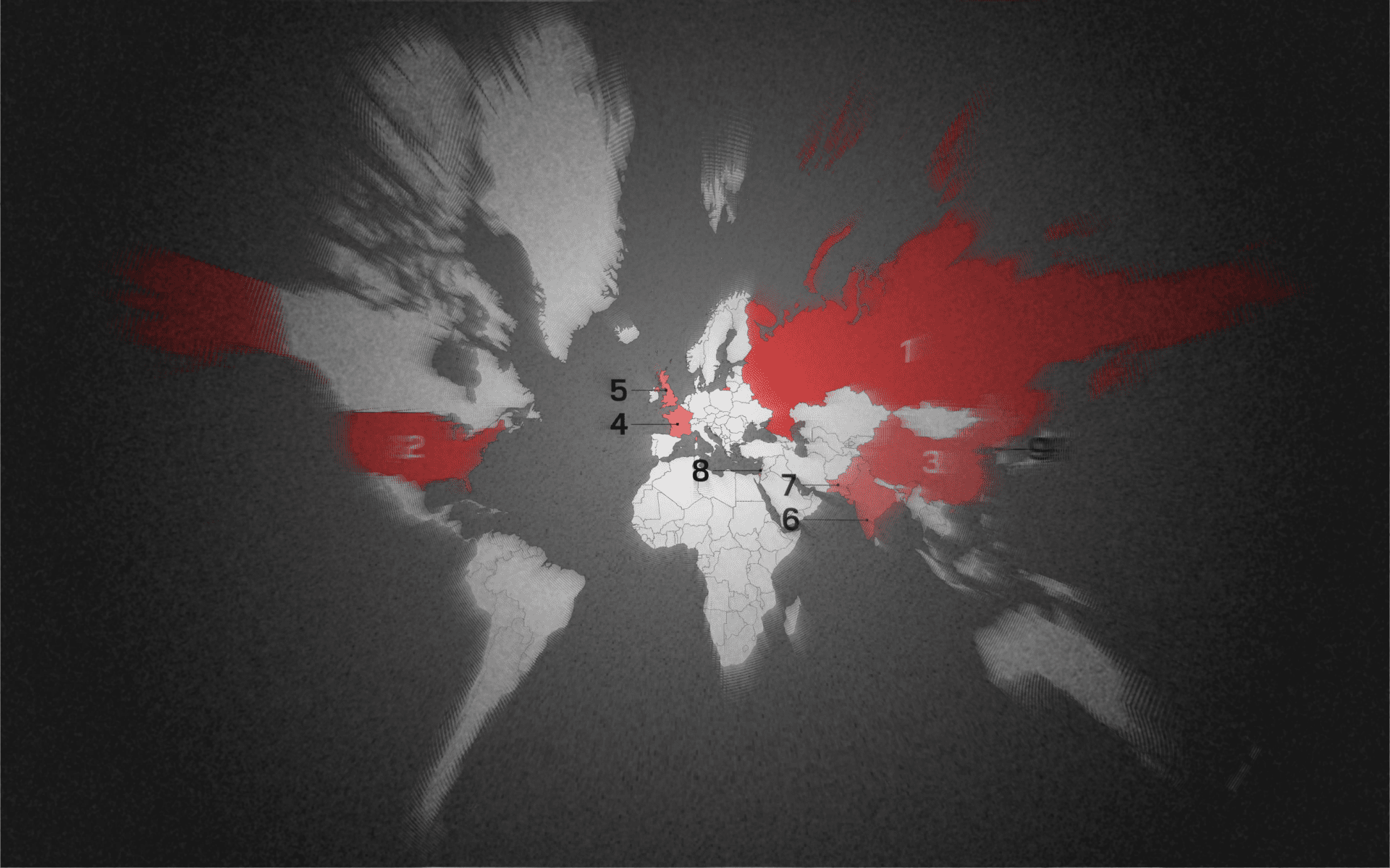
Amid escalating global threats and mounting concerns over Russia, the UK is expanding its nuclear fleet for the first time since the Cold War. Which countries have nuclear weapons, what nuclear weapons do they have, and how is Moscow destabilizing the already fragile nuclear order?
The UK announced purchasing 12 new F-35A fighter jets from the US on June 24—“the biggest strengthening of the UK’s nuclear posture in a generation.” For the first time since the Cold War, the Royal Air Force will regain a nuclear role, supplementing the UK’s current maritime-only deterrent.
In an era of radical uncertainty, we can no longer take peace for granted, which is why my government is investing in our national security.
Keir Starmer
UK Prime Minister
The move comes as nuclear weapons dominate the headlines. In June 2025 alone, the US launched airstrikes on Iran's nuclear sites; the World Bank agreed to fund nuclear projects for the first time since 1959; countries like Poland are moving forward with their first-ever nuclear power initiatives.
Today, 410 working nuclear reactors operate across 32 countries worldwide, according to the World Nuclear Industry status report.
But only five states are designated nuclear weapons states (NWS) as part of the Nuclear Non-Proliferation Treaty (NPT)—one of the most widely adhered-to international treaties in terms of arms control and international security. And one of them—Russia—stands accused of violating it, particularly regarding its war in Ukraine and nuclear disarmament.
Russia has put the purpose of the non-proliferation regime on its head: The NPT’s permission of Russian possession of nuclear weapons has helped Moscow to conduct its expansionist and genocidal war against Ukraine.
Analyst at the Stockholm Center for Eastern European Studies
What is the nuclear Non-Proliferation Treaty?
The Non-Proliferation of Nuclear Weapons Treaty (NPT) came into force in 1970. It aims to prevent the spread of nuclear weapons and promote global disarmament. Today, 190 states are party to the treaty, divided into nuclear-weapon states (NWS) and non-nuclear-weapon states (NNWS).
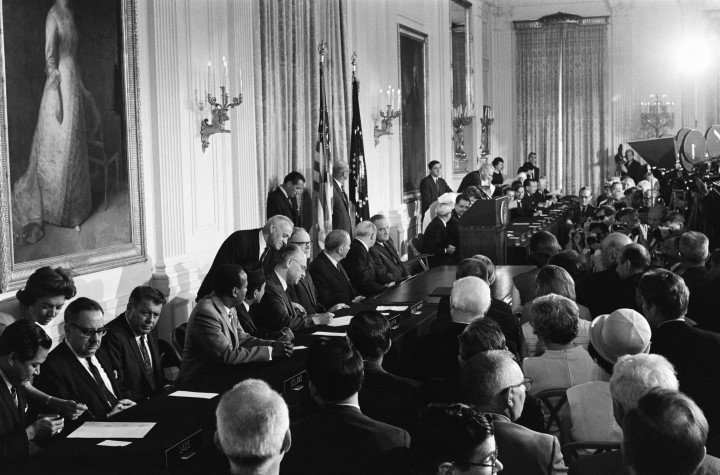
Under the agreement, the five recognized NWS—China, France, Russia, the UK, and the US—commit to pursuing nuclear weapons disarmament. Most remaining countries globally are NNWS.
The treaty explicitly prohibits any transfer of nuclear weapons by NWS to NNWS or to “assist, encourage, or induce any NNWS” to manufacture or otherwise acquire nuclear weapons. South Sudan, India, Israel, and Pakistan remain outside the treaty.
To join, India, Israel, and Pakistan would be required to do so as NNWS, meaning they must dismantle their existing nuclear arsenals and place them under international safeguards.
Ukraine was once an NWS, but in 1994 it gave up its world’s third-largest nuclear arsenal in exchange for security assurances from Russia, the US, and the UK, who signed the Budapest memorandum, pledging to respect Ukraine’s sovereignty and borders and not to threaten it or use force by any means. Thus, Ukraine joined the NPT as an NNWS—a nuclear-free state.
Which countries have nuclear weapons?
Due to the secrecy surrounding nuclear programs, warhead and weapons counts are based on estimates, not confirmed data.
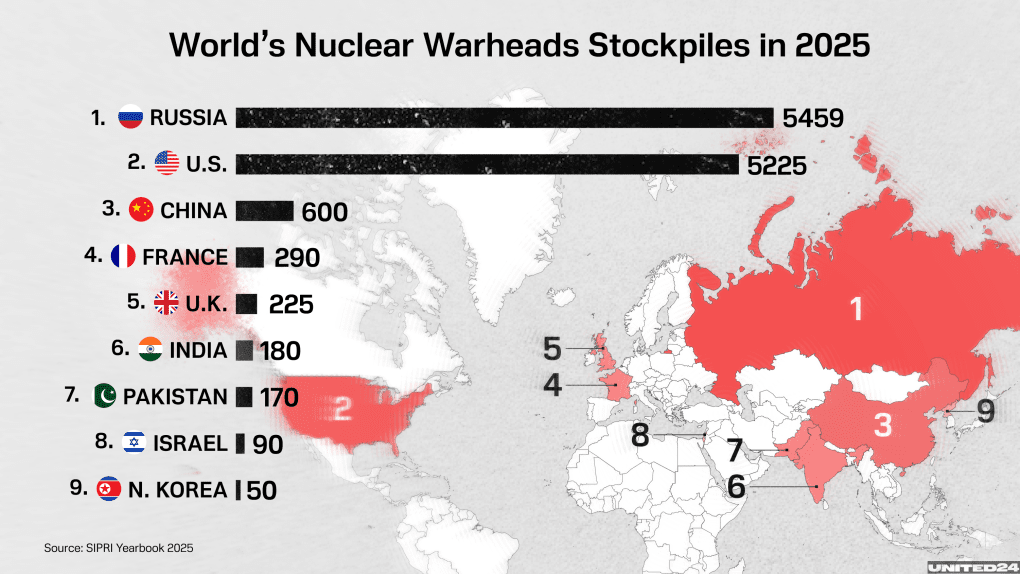
As of March 2024, NWS possesses a combined total of around 12,100 nuclear warheads, with nearly 90% of them belonging to Russia and the US, according to the US organisation Arms Control Association (ACA).
Beyond the NPT framework, India, Pakistan, and Israel also possess nuclear weapons.
India: Estimated 172 nuclear warheads
Pakistan: Around 170 warheads
Israel: Roughly 90 warheads, with enough fissile material for up to 200
Russia
Russia holds the world’s largest nuclear stockpile– an estimated 5,580 nuclear weapons, with 4,380 operational, and 1,200 awaiting dismantlement.
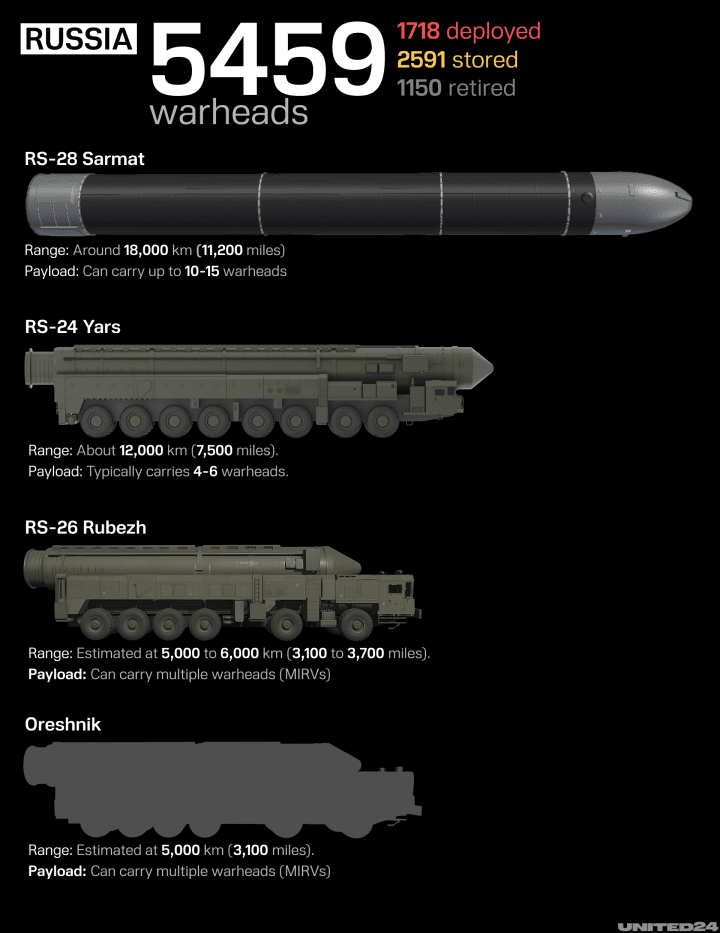
What kind of nuclear weapons does Russia have? Its nuclear triad includes:
Intercontinental ballistic missiles (ICBMs)
Submarine-launched ballistic missiles (SLBMs),
Long-range strategic bombers like the Tu-160 and Tu-95, all capable of delivering nuclear warheads.
ICBMs are the cornerstone of Russia’s nuclear strategy. Since 2022, Moscow has accelerated testing and deployment, undermining its NPT disarmament obligations.
Russia’s key ICBM systems:
RS-28 Sarmat (“Satan 2”) replacing the aging SS-18 “Voyevoda”
RS-24 Yars
Topol-M (being phased out in favor of the Yars and Sarmat)
RS-26 “Rubezh”
Kedr (in development)
Russia’s leader, Vladimir Putin, announced on June 23 the mass production of the Oreshnik missile. It has both conventional and nuclear capabilities and has already been used to attack Ukraine.
Russia also launched its 3M22 Zircon hypersonic missile, capable of carrying nuclear warheads, at Ukraine at least six times in 2024.
The Russian Air Force fields 67 long-range bombers carrying up to 586 warheads. The Tu-95 and Tu-160 deploy nuclear cruise missiles like the Kh-55 and Kh-102, while the Tu-22M serves as a tactical nuclear platform.
Ukraine struck back on June 1, 2025. In Operation Spiderweb, Ukraine destroyed 41 Russian aircraft, including Tu-95s, Tu-160s, Tu-22M3s, and an A-50 AWACS, inflicting an estimated $7 billion in damage to Russia’s strategic aviation.
-04df4aadbcb4826e9e7fd30da33613f4.jpg)
China
China currently has around 600 nuclear warheads, and the US estimates that number to reach 1,000 by 2030.
Over the last five years, China has significantly expanded its ongoing nuclear modernization program, fielding more nuclear weapons than ever before. China has also expanded its silo fields—used to load solid-fuel missiles and liquid-fuel missiles—building at least 300 since 2021.

What is in China’s nuclear arsenal? China deploys a mix of:
Land-based ballistic missiles,
Sea-based ballistic missiles,
Strategic bombers.
It is also thought to have produced nuclear weapons to eventually arm road-mobile and silo-based missiles and bombers, ACA reported.
Of China’s 462 ICBM launchers, about 170 can reportedly launch nuclear missiles. China’s silo expansion leaves experts uncertain about how many ICBMs China truly operates. Its newest silos are believed to be fueling the DF-41s and DF-5 variants.
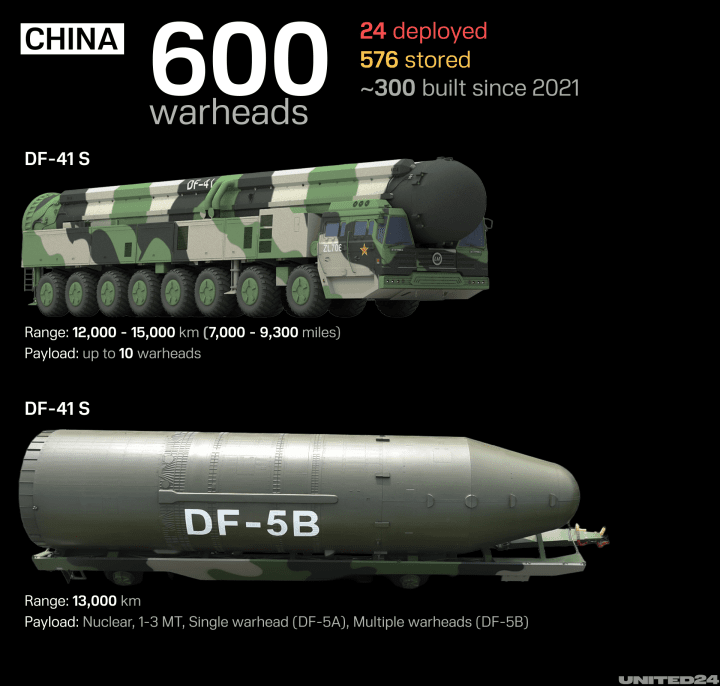
France
France maintains the world’s fourth-largest nuclear arsenal and adheres to “strict sufficiency” by keeping its arsenal at the lowest possible level solely for a “life-insurance policy,” ACA reports.
France eliminated its land-based ICBMs in 1996 and has taken significant steps toward disarmament by halving its nuclear capabilities since its Cold War peak.
What nuclear weapons does France have? France has 290 varying nuclear warheads, deployed across:
Submarine fleet consisting of nuclear-propelled attack (SSNs) and nuclear-powered ballistic missile submarines (SSBNs),
Air-launched cruise missiles allocated for dual-capable land and carrier-based Rafale fighter jets
The Rafale F3-R multirole fighter jet is equipped with the ASMPA (Air-Sol Moyenne Portée-Amélioré) missile, which is a supersonic, nuclear-capable cruise missile. France is now expanding its Rafale fleet, accelerating the development of the ASN4G, a next-generation hypersonic missile set to replace the current ASMPA—reportedly in response to growing security threats from Russia.
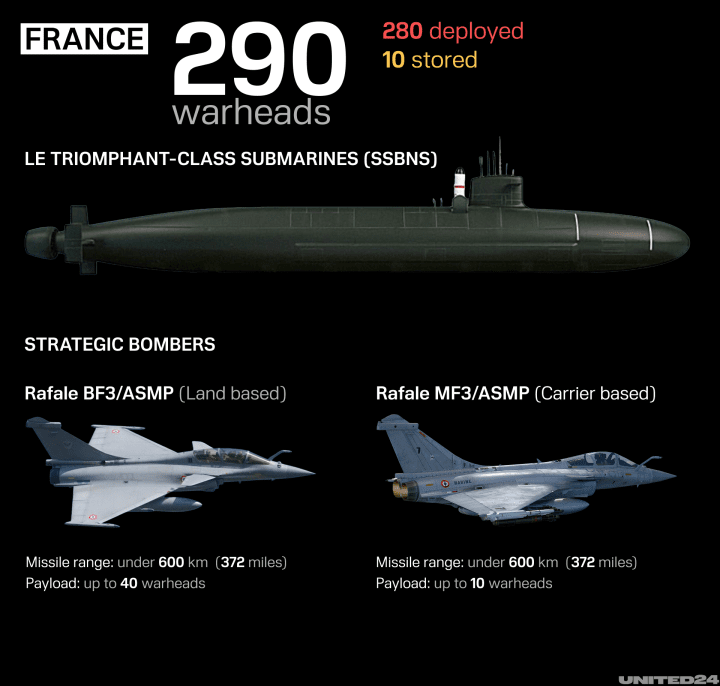
France is also boosting its defense budget—from 2% to 3.5% of GDP—signaling a major shift in European military posture.
France’s sea-based nuclear force is anchored by the backbone of its nuclear deterrent, the four Le Triomphant-class submarines, carrying approximately 80% of its nuclear arsenal. These submarines are armed with:
M51.1 missiles (with TN75 warheads)
M51.2 missiles (carrying TNO warheads, reportedly stealthier than the TN75)
M45 missiles on three older subs
M51 SLBMs on Le Terrible, the newest sub, each capable of deploying six MIRVs—warheads that can independently strike separate targets
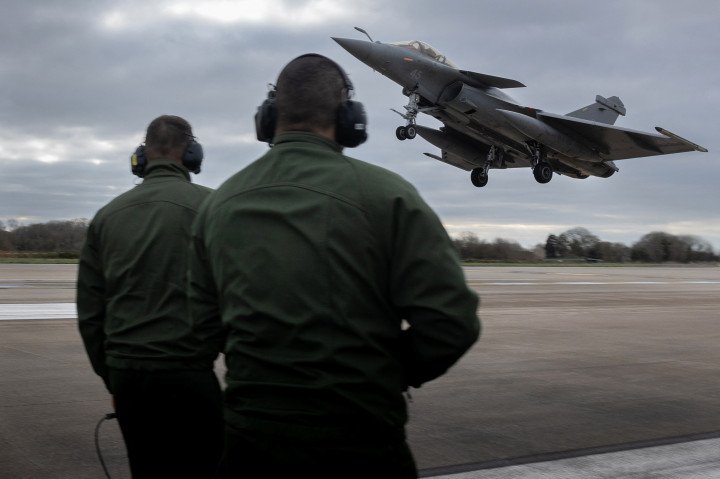
UK
The UK has an estimated 120 operational nuclear weapons, with another 105 nuclear weapons in storage—the smallest deployed arsenal of the NWS.
What nuclear weapons does the UK have?
Four Vanguard-class submarines, each equipped to carry the US-leased Trident II (D5) SLBM
Only one sub patrols at a time, and launch readiness takes several days. These submarines are gradually being replaced by four new Dreadnought-class submarines as part of a long-term modernization effort.
Each vessel can launch up to 16 Trident missiles. While the UK capped the loadout at eight missiles per sub in 2019, it announced in 2021 that it would no longer publicly disclose the operational number.
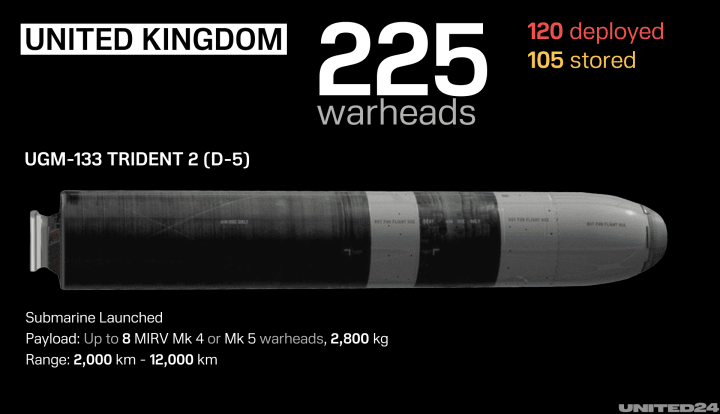
Unlike other nuclear powers, the UK has no ICBMs or nuclear-capable aircraft and maintains a sea-only nuclear deterrent—a strategy it committed to in 1998 when it dismantled its last gravity-based nuclear bombs.
In response to growing Russian threats, the UK government announced in June 2025 a major nuclear posture shift:
Reintroducing a nuclear air role for the Royal Air Force
Purchasing 12 US-made F-35A fighter jets, capable of launching B61 tactical nuclear bombs
US
The US has an estimated 5,225 nuclear warheads: 1,770 deployed, and roughly 1,930 in the reserve stockpile, while the rest are retired, awaiting dismantlement. The US previously had both chemical and biological weapons, which have now been destroyed.
What is the US nuclear arsenal? It’s the world’s most diverse, built on a triad of ICBMs, SSBNs, and strategic bombers.
The US nuclear triad includes:
Land-based: the 400 LGM-30G Minuteman III ICBMs, set to be replaced by the LGM-35A Sentinel between 2029-2035.
Sea-based: 14 Ohio-class SSBNs, each outfitted with 20 missile tubes for Trident II (D5) SLBMs.
Air-based: 46 B-52H Stratofortress bombers and 19 B-2A Spirit stealth bombers—used for the first time during strikes on Iran’s nuclear facilities.
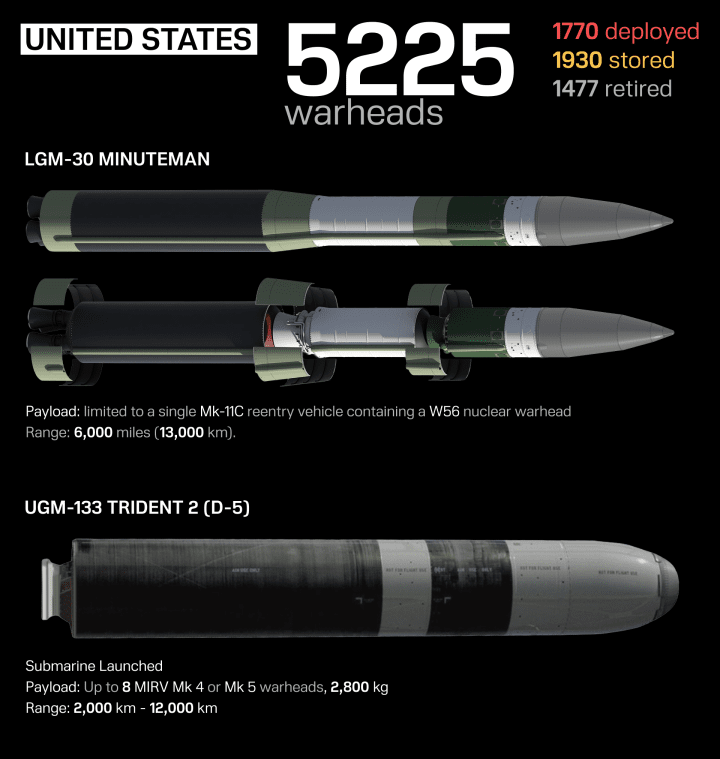
The US also fields the F-15E and F-16C, dual-capable fighter jets armed with B61 gravity bombs. The F-16, long main tactical nuclear platform, and praised in Ukraine, is being phased out for the next-generation F-35 Lightning II.
An estimated 100 B61 bombs are forward-deployed at six NATO air bases across five European countries: Italy, Germany, Türkiye, Belgium, and the Netherlands.
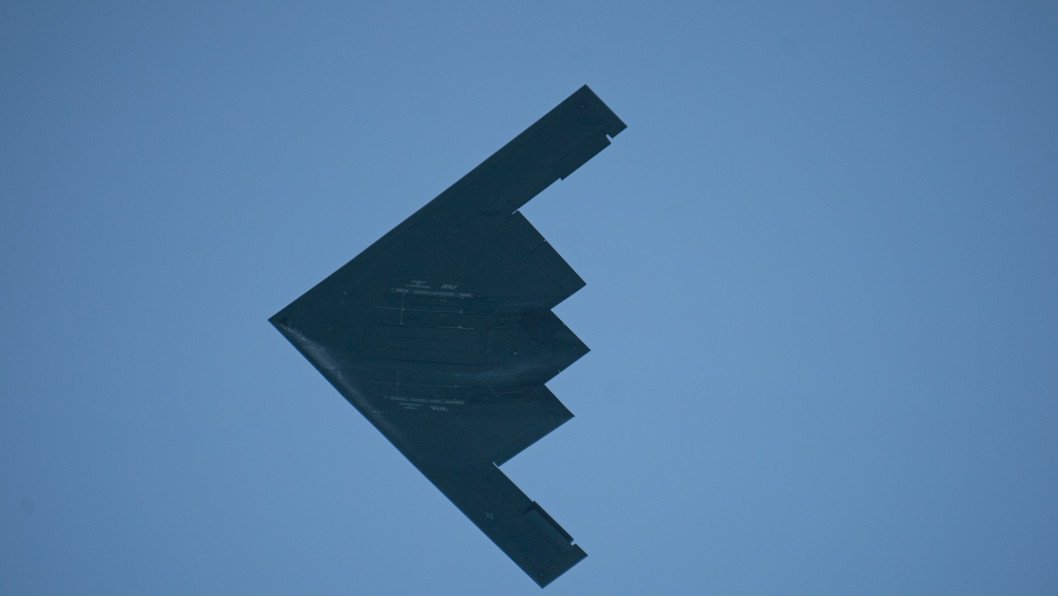
Does the Non-Proliferation Treaty still work?
The NPT has been partially successful in curbing nuclear weapons proliferation; countries such as France and the UK abide strictly by its obligations and use nuclear weapons only as a safeguard.
However, several countries have been accused or confirmed to have violated the NPT, either by conducting undeclared nuclear activities, pursuing weapons programmes, or breaching their obligations.
Russia is developing new nuclear ‘warfighting’ systems and has demonstrated irresponsible nuclear signalling designed to deter NATO support during Russia’s invasion of Ukraine. China is rapidly expanding and modernising its nuclear arsenal; the Democratic People’s Republic of Korea is continuing with its destabilising nuclear weapons programme; and Iran’s escalating nuclear activity continues to pose risks.
For more than a decade, the US government has had concerns about China’s proliferation of nuclear missile-related technology to other countries. While the US says that China has ended its direct involvement, Chinese-based companies and individuals continue to export relevant goods, specifically to Iran and North Korea, US Congress reported in April 2025.
The US launched an attack on June 22 on Iran’s nuclear sites due to its expanding uranium enrichment program, reportedly leading the nation dangerously close to nuclear weapon capabilities, which Tehran denies. Iran is an NNWS, and says that it has a legitimate right to use nuclear energy peacefully.
In recent years, positioned as civilian aid, Russia has accelerated Iran’s nuclear capabilities, technically bringing it closer to a weapons-grade threshold, against its obligation as part of the NPT.
Israeli Prime Minister Benjamin Netanyahu stresses that Iran has nuclear weapons, which began tensions and conflict in the region. However, Israel also has nuclear weapons and is not an NWS, nor has it signed up to the Nuclear Non-Proliferation Treaty (NPT).
North Korea withdrew from the NPT in 2003 and has since tested nuclear weapons. Libya reportedly engaged in covert nuclear activities by acquiring blueprints for nuclear weapons through a black market, with a network led by Pakistani scientist Abdul Qadeer Khan. Libya was then able to process uranium through a series of deals involving North Korea and Pakistan.
Recent US–Iran negotiations have prompted analysts and policymakers to invoke the so-called “Libya model”—a reference to Libya’s voluntary dismantling of its nuclear program in exchange for diplomatic and economic benefits.
How Russia undermines the Non-Proliferation Treaty
Nuclear blackmail
Russia is widely seen as the key underminer of the treaty’s credibility. Since the beginning of Russia’s full-scale invasion of Ukraine, Moscow has repeatedly resorted to nuclear threats to intimidate the West and deter support for Ukraine. Russia’s threats have delayed response from the West, such as prividing Kyiv with Germany’s Taurus missile, amid fears of escalating tensions.
Russia’s “nuclear blackmail” is widely seen as a violation of the NPT, which calls for states to pursue disarmament.
The NPT’s restriction on Ukraine maintaining nuclear weapons has left Kyiv without a nuclear deterrent in the face of Russia’s escalating aggression since 2014.
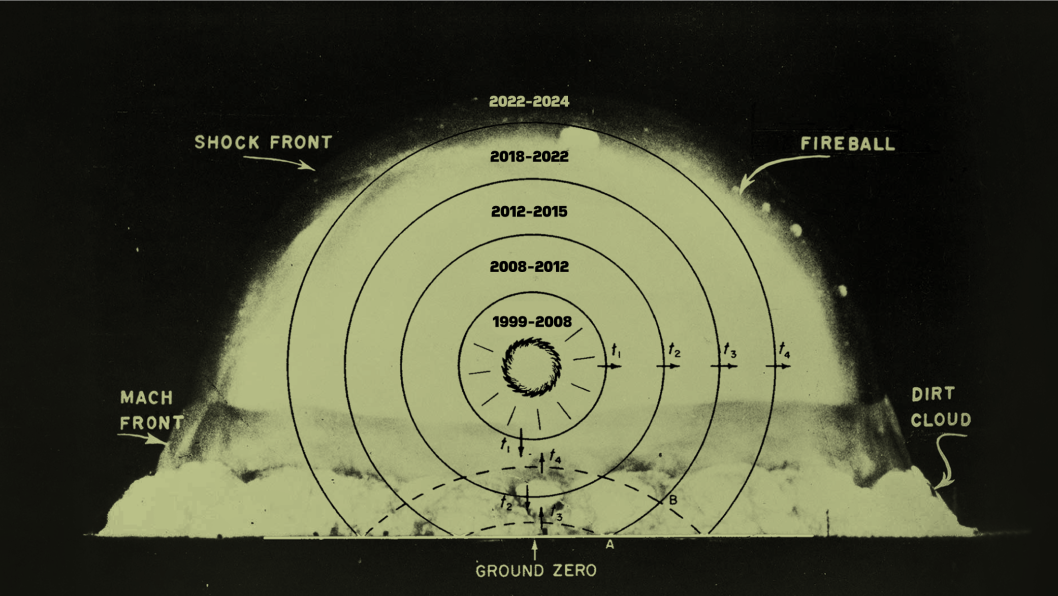
Removing itself from arms treaties
Russia has withdrawn from several arms control measures:
In February 2023, Moscow suspended its participation in the New START Treaty, the final remaining bilateral treaty with the United States limiting strategic nuclear arsenals. While not officially withdrawn, the suspension effectively eliminated inspection rights and data sharing, both core treaty obligations.
In October 2023, Russia revoked its ratification of the Comprehensive Nuclear-Test-Ban Treaty (CTBT), continuing to adopt an aggressive nuclear stance throughout its war in Ukraine.
In 2019, Russia withdrew from the Intermediate-Range Nuclear Forces (INF) Treaty, which aimed to eliminate ground-launched nuclear missiles with a range of 500 to 5,500km (300 to 3,400miles)
Accelerating Iran and North Korea’s nuclear capabilities
Following Russia’s full-scale invasion of Ukraine, military cooperation with Iran and North Korea has accelerated, including directly supporting their nuclear weapons programs.
Russia has “abandoned” its role in the NPT, “instead fostering nuclear proliferation to further its military objectives”, the Center for Strategic International Studies (CSIS) says.
Russia provides Iran with nuclear scientific support, engaging in covert meetings to further Iran’s expertise. Iranian scientists have visited Russian nuclear laboratories, and Russian scientists have directly contributed by developing a detonator and high explosive for its nuclear program.
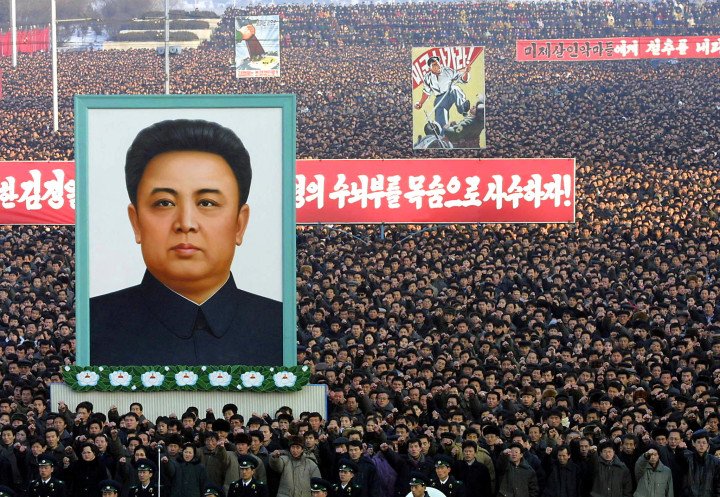
Russia’s deepening relationship with North Korea is particularly alarming, Center for Strategic and International Studies (CSIS) says. Russia has notably enhanced North Korea’s KN-23 ballistic missiles, also known as Hwasong-11, improving their effectiveness in striking civilian targets in Ukraine. These missiles are dual-capable, designed to carry both conventional and nuclear warheads.
In exchange for nuclear support, Iran and North Korea have provided Russia with drones, missiles, and other arms. North Korea has also sent troops to aid Moscow’s war in Ukraine, with more expected in July 2025.
Moscow’s abandonment of non-proliferation principles could signal to other countries that there are fewer consequences for pursuing nuclear weapons, encouraging proliferation around the globe.
Center for Strategic and International Studies
Together, these actions have weakened the core norms of non-proliferation, signaling Russia’s willingness to use nuclear threats as a tool of coercion. Russia’s actions continue to violate the treaty and risk further destabilizing the already fragile global nuclear order.
-46f6afa2f66d31ff3df8ea1a8f5524ec.jpg)
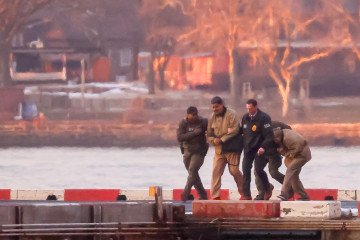
-29a1a43aba23f9bb779a1ac8b98d2121.jpeg)
-c9be02aad2c169e14ebc2a41d0ba02dc.jpg)
-605be766de04ba3d21b67fb76a76786a.jpg)
-56e0bfa71829348120777fba0ad5ba46.png)

